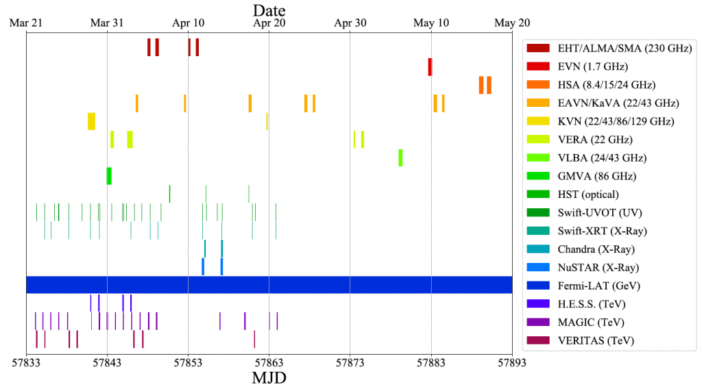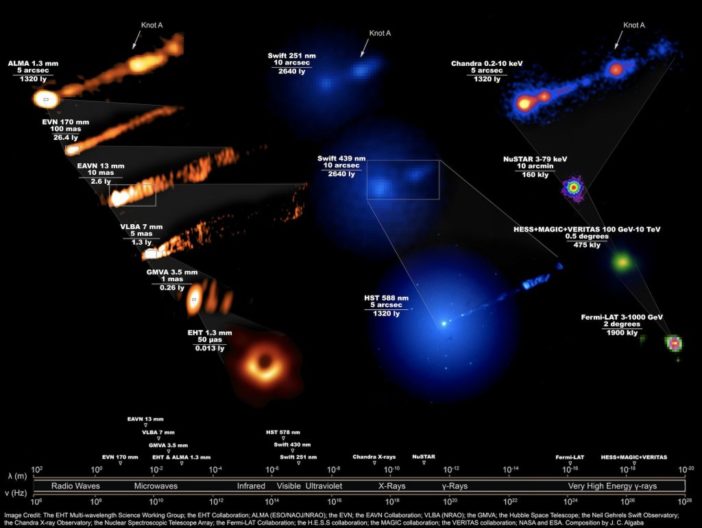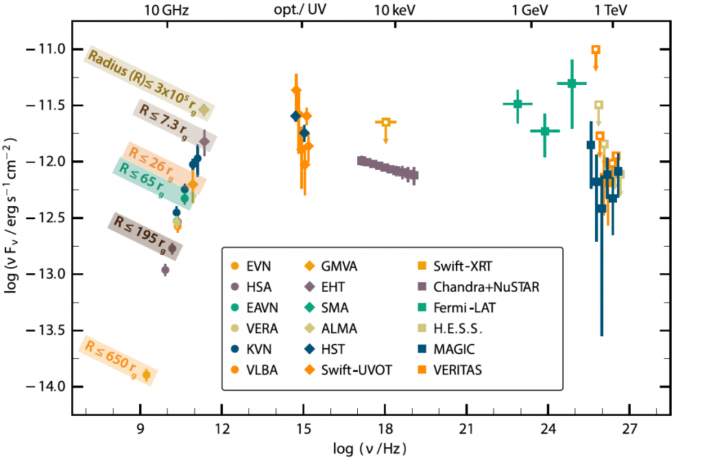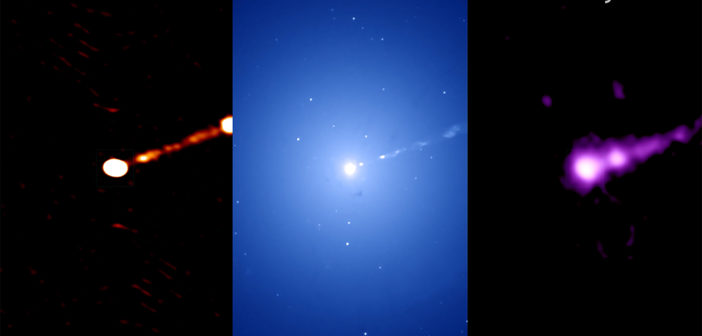Editor’s note: Astrobites is a graduate-student-run organization that digests astrophysical literature for undergraduate students. As part of the partnership between the AAS and astrobites, we occasionally repost astrobites content here at AAS Nova. We hope you enjoy this post from astrobites; the original can be viewed at astrobites.org.
Title: Broadband Multi-wavelength Properties of M87 during the 2017 Event Horizon Telescope Campaign
Authors: The Event Horizon Telescope Multi-wavelength Science Working Group
First Author’s Institution: N/A
Status: Published in ApJL
M87 is a galaxy of extremes — it is one of the brightest radio sources in the entire sky, one of the nearest galaxies that has a relativistic jet emitted from its nucleus, and one of our nearest extragalactic neighbors (a measly 53 million light-years away, in the Virgo Cluster). Also, in 2019, M87 made the news for hosting the subject of the first ever image of a black hole “shadow” (check out the Astrobites coverage of that historic event here).

The first detailed image of a black hole, M87, taken with the Event Horizon Telescope. [Adapted from EHT collaboration et al 2019]
Reducing these uncertainties is imperative if we want to have a better understanding of M87, but radio observations alone cannot accomplish this. Luckily, input from other wavelengths can go a long way in complementing the radio observations. For example, previous multi-wavelength studies of M87 guided our understanding that M87 must have a non-zero spin.
A difficulty, however, is coordinating these observations. The emission from supermassive black holes (SMBHs) of M87’s size — and the jets that they launch — is known to fluctuate on timescales of a few weeks. Thus, to get a complete snapshot of a SMBH, you want to look at it in many wavelengths at roughly the same time. This is exactly what the authors of today’s paper accomplished.
This coordination of telescopes was no small feat. In total, 17 telescopes across as many orders of magnitude in frequency (from 1 GHz to 1018 GHz) came together to image the nucleus and jet of M87 in 2017. The schedule of the different observations from each telescope is displayed in Figure 1.

Figure 1: Schedule of when each telescope was observing M87 in 2017. The telescopes are ordered by frequency, with red being the lower frequencies (radio). Fermi-LAT normally operates in a survey mode, which is why there is data from every day. [The EHT MWL Science Working Group et al. 2021]

Figure 2: Compilation of the near-simultaneous observations of M87. Note the different angular scales, and how some of the radio observations on the left are able to differentiate features in the jet, whereas gamma-ray observations (right) cannot discriminate between these features. [EHT Collaboration; NASA/Swift; NASA/Fermi; Caltech-NuSTAR; CXC; CfA-VERITAS; MAGIC; HESS]
For example, if there are electrons in the jet, then they will emit synchrotron radiation as they spiral around magnetic field lines. This causes a bump in the SED at radio frequencies. Some of the synchrotron radiation can then actually interact with the same electrons, and get scattered up to very high energies, which can cause another bump in the SED at very high energies. Different predictions for, say, the distribution of electrons or the magnetic field strength will change the locations and magnitudes of these “bumps,” and so we can use the SED to infer characteristics about the composition of the jet. The SED from M87 is shown in Figure 3.

Figure 3: Broadband spectral energy distribution (SED) of M87 from 2017. The SED represents the amount of energy arriving at Earth at each of these frequencies. Different features in the SED can reveal valuable information about the environments producing the emission. [The EHT MWL Science Working Group et al. 2021]
From a deep look at M87’s SED, the authors come to the conclusion that a simple model of the emission — one that treats all of the emission as coming from the same location in the jet — cannot explain the entire SED. This lends evidence to the hypothesis that M87’s jet must have a more complex structure, and that the very high-energy gamma rays might be originating from a different region of the jet than the emission at lower frequencies.
Not only are the scientific takeaways from this work extremely informative, but it represents a massive success in uniting some of the most advanced telescopes in the world to create one of the most detailed snapshots of an AGN to date. These observations will serve as a cornerstone for future observations of M87, which will revolutionize our understanding of black holes and relativistic jets.
Original astrobite edited by Viraj Karambelkar.
About the author, Alex Pizzuto:
Alex is a PhD candidate at the Wisconsin IceCube Particle Astrophysics Center at the University of Wisconsin-Madison. His work focuses on developing methods to locate the universe’s most extreme cosmic accelerators by searching for the neutrinos that come from them. Alex is also passionate about local science outreach events in Madison, and enjoys hiking, cooking, and playing music when he is not debugging his code.

